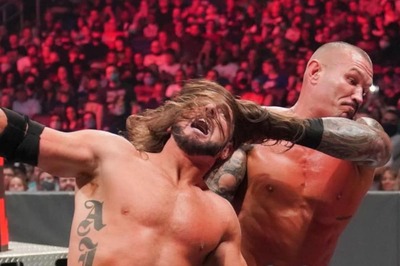
views
The Palestine-Israeli conflict has always had intense religious and emotional sentiments attached to Kashmiris. We grew up hearing about Palestinian resistance to Israel “occupying” Gaza, the West Bank, and the Golan Heights. In the days of DD news channels, daily reports of deaths in those regions were staple news. When the Kashmir Valley erupted in the winter of 1989-90, it was easy for the general populace to adopt the ‘Indian occupation’ narrative, similar to the one produced by the Intifada—spread by moderate civil society, OGWs (Over Ground Workers) of terrorists in the media, secular politicians, and Islamist academicians working at the behest of Pakistan’s terror state.
Certain areas notorious for frequent stone-pelting came to be known as Kashmir’s ‘Gaza’ or ‘Gaza Strip,’ such as downtown Nowhatta and, of course, Maisuma—the ancestral home of Yasin Malik, the JKLF terrorist responsible for killing Air Force personnel and many Pandits, who is currently in Tihar jail.
For those of us who attended English medium schools, particularly missionary ones, it was common to find Anne Frank’s The Diary of a Young Girl in the school library, the Municipal Library, or the Sri Pratap Singh State Library across the Jhelum River, a place we frequented. I grew up reading Holocaust literature, largely thanks to Reader’s Digest, which was delivered monthly to our home until the leftist takeover of its Bombay office in the post-90s period. My heroes were Simon Wiesenthal, the towering figure who tracked down Nazi war criminals; Raoul Wallenberg, the Swedish diplomat who saved Jews during those dark days; and Miep Gies, the woman who sheltered Anne Frank’s family and preserved her iconic diary after they were captured by the SS Nazis.
Years later, when DVDs became widely available, Schindler’s List by Steven Spielberg was a much-watched film in our home. There was no ambiguity regarding the two-state solution—Palestine deserved a state, and the Palestinians, a country, but Israel’s right to exist was never in question. After all, Moses is also a prophet mentioned in the Quran, and Jews, along with Christians, are regarded as People of the Book.
As children, we watched Yasser Arafat, the PLO leader, hug and kiss the Indian leaders on TV in the televised Non-Aligned Summits. We cringed as my mother laughed and gave him the nickname “Mouenal” (kisser), embarrassed that he would repeat the melodramatic greeting with every single person. It was during adulthood that I realised India also stood for a two-state solution. But by then, a decade of Islamic Jihad had already gripped us, and 9/11 was on the horizon.
As we, secular, liberal and rational Kashmiris started connecting the dots, it became clear that the kind of freedom (azadi) the Kashmiris wanted for the Valley – one without Kashmiri Pandits – was the same as what the Palestinians wanted for Israel through the Intifadas. Eventually, we learned that in the 1970s and ’80s, through exchange programs, Palestinian students had been enrolled in Kashmir University. Much of the guerrilla warfare that came later stemmed from Palestinian resistance groups. As a teenager and a voracious reader, I recall coming across a lot of “mujahideen” literature in relatives’ attics and old trunks – magazines full of images of the Iran-Iraq war – never understanding that this was Muslims killing Muslims. But bizarrely, the elders always blamed the Yehood (Jews).
There is a Bollywood movie—Yehudi ki Beti—which my aunt, a Bollywood aficionado, would fondly recall, ignoring the derision the title elicited from others. Just as we started unlearning the truth about the Islamic Jihad in Kashmir and how it was sponsored by Pakistan’s ISI, this past year, since 7 October, has been an experience of unlearning, relearning, and learning about the Palestinians and the Palestine-Israeli conflict. Social media accounts made it possible to hear how rational Palestinians themselves were held hostage by the Hamas terror brigades. It was similar to us dissenting Kashmiri Muslims under the Intifada factory, both armed units and the terror apologist national and regional media, as well as the civil society that dominated the narrative of “Kashmir wants to secede from India”.
I could relate to the pro-Israeli accounts from Palestinians settled in the West, who kept correcting the propaganda of Al Jazeera and what is now infamously called “Pallywood”.
It was disconcerting to find patterns in the portrayal of the IDF forces when battling Palestinian terrorists and dealing with stabbing incidents, similar to the Kashmiri media painting the Indian Army as villains every time a civilian was collateral damage in the proxy war between security forces and the terror groups. The Western media, including The Washington Post, The New York Times, and the ever-ready Al Jazeera, picked up on this narrative and fed the “Indian occupation” and “settler-colonial” canards. It was a revelation to see what Arab nations thought of Palestinian society, with their leaders, entrepreneurs, influencers, and journalists talking openly about how the Palestinians would keep blackmailing the Arabs for more aid while never sitting at the negotiating table.
It was educational to learn from Israelis how the Palestinian leadership had repeatedly rejected peace with Israel, even after Israel forcibly vacated families from what is termed “settler-colonial” regions to give peace with the Palestinians a chance. However, the Palestinians would agree to nothing short of “from the river to the sea,” which signifies the destruction of Israel.
It resonated with us when Islamic Jihad was at its peak, and we were losing children on the streets to agitations and protests orchestrated by various toolkits employed by anti-India forces. The authorities, interlocutors, and others would keep pleading with the Hurriyat to give up their ‘hartal calendar’, as it had crippled the economy of the Valley and most affected the poorer sections of society. But just like the Palestinian Authority in their palaces with private jets and dollars, the Hurriyat in their palatial bungalows and three-storey homes would snub those negotiators, satisfied in the knowledge that their sons and daughters were safely ensconced in Ivy League universities in the West, Turkey, and Iran while low-income families lost their sons to their ‘azadi jihad’ against India.
It has been a year of seeing similarities between Palestinian society, which refuses to come to an accord with Israelis, and our own, who gleefully accept that the BJP’s abrogation of Article 370 has brought peace and development to the region, yet they still won’t vote for the “Hindu” party. The anti-Semitism among Kashmiris runs deep, much of it nurtured since the 1960s and 70s, with a wealth of oral history and folklore passed around as facts.
So, it should not surprise anyone if rallies in favour of Hezbollah and mourning for Hasan Nasrallah are seen on the streets of Kashmir. Average Kashmiris are not prone to nuance or ready to hear the other side. Adding to this is the anti-Semitism and Hindu hatred of decades, resulting in an entire radicalised population that is like a powder keg waiting for the first spark. It is important to note that these few families are the loudest, and the media covers them the most, creating the perception that the entire Valley speaks with one voice. This is not the case; the silent majority is present and will always remain silent, considering it is a tribal society, where the repercussions for dissent are ostracism—worse than death—which was the norm when terrorists would label anyone a ‘mukhbir’ (collaborator) and execute them on a whim.
These loud Islamist families listen to their community elders and imams, lap up the rhetoric of political leaders, and storm the streets to protest the “attack on Islam and Muslims” by the Yehood, not bothering to hear the lived experiences of those who bore the brunt of the terror inflicted by Hasan Nasrallah and Hezbollah over the decades. Nor does it matter to them that Lebanon, once peaceful, has been converted into a war zone by Hezbollah or that it has served as a proxy for Iran to realise its geopolitical ambitions in the region. Understanding, reading, talking to people from other cultures and religions, and keeping an open mind is hard work. The past decades, marked by ‘economic packages’ and constant appeasement policies post-abrogation, have made life easy for the Kashmiris. Hence, be prepared for more such rallies driven by the whims of political dynasts and other political leaders campaigning for votes. The camaraderie between Shia and Sunni political leaders is amusing to observe, considering the animosity the two communities generally have for each other. Video clips cursing the Jews and showing solidarity with Shia mourners, just to snub the Hindus, are a staple media byte here.
It would also be amusing to know what they think of the custodian of the two holy cities of Islam, Prince Mohammad bin Salman’s latest statement of not personally caring for the Palestinians or desisting Hajj pilgrims from making political statements at the sacred grounds of the Kaaba. In my humble opinion, his takfiri-ism (declaring him not Muslim enough) began last year when Saudi Arabia started opening up a bit to concerts, women drivers, the abolition of the male relative escort rule, and the possibility of normalising ties with Israel. This takfiri-ism is set to continue this year as well.
There will not even be an acknowledgement that a significant portion of Israel consists of Druze Muslims, for whom it is not mandatory to serve in the IDF, but who do so voluntarily and were victims of the October 7 Hamas attacks as well. Recently, a Hezbollah rocket attack killed 12 Druze children who were playing football in a field, and the Druze Israelis have vowed to avenge them. However, this fact will be lost on those who have ambiguity regarding their nationhood, identity, and history.
Those who, not long ago, attended terrorists’ funerals and viewed Burhan Wani as a freedom fighter will never listen to Palestinians who want Hamas to go or to the Lebanese who are preparing to throw Hezbollah out of their country.
The author is a writer and an educationist from Srinagar. Views expressed in the above piece are personal and solely those of the author. They do not necessarily reflect News18’s views.


















Comments
0 comment